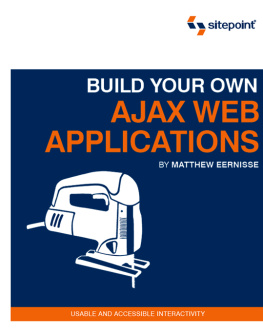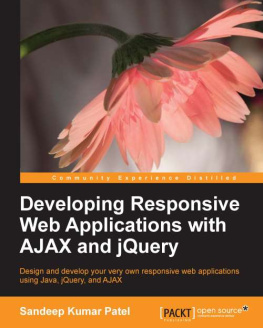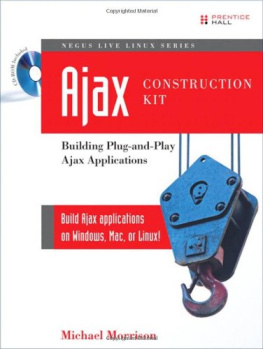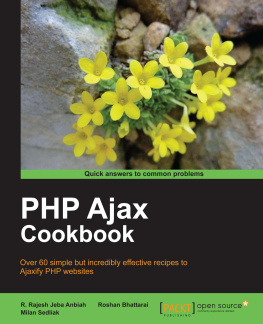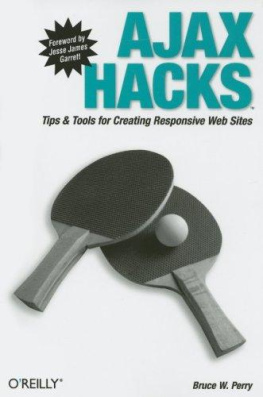Michael Morrison [Michael Morrison] - Negus Live Linux Series Ajax Construction Kit: Building Plug-and-Play Ajax Applications
Here you can read online Michael Morrison [Michael Morrison] - Negus Live Linux Series Ajax Construction Kit: Building Plug-and-Play Ajax Applications full text of the book (entire story) in english for free. Download pdf and epub, get meaning, cover and reviews about this ebook. year: 2007, publisher: Prentice Hall, genre: Computer. Description of the work, (preface) as well as reviews are available. Best literature library LitArk.com created for fans of good reading and offers a wide selection of genres:
Romance novel
Science fiction
Adventure
Detective
Science
History
Home and family
Prose
Art
Politics
Computer
Non-fiction
Religion
Business
Children
Humor
Choose a favorite category and find really read worthwhile books. Enjoy immersion in the world of imagination, feel the emotions of the characters or learn something new for yourself, make an fascinating discovery.
- Book:Negus Live Linux Series Ajax Construction Kit: Building Plug-and-Play Ajax Applications
- Author:
- Publisher:Prentice Hall
- Genre:
- Year:2007
- Rating:3 / 5
- Favourites:Add to favourites
- Your mark:
Negus Live Linux Series Ajax Construction Kit: Building Plug-and-Play Ajax Applications: summary, description and annotation
We offer to read an annotation, description, summary or preface (depends on what the author of the book "Negus Live Linux Series Ajax Construction Kit: Building Plug-and-Play Ajax Applications" wrote himself). If you haven't found the necessary information about the book — write in the comments, we will try to find it.
Supercharge Your Sites with Ajax Right Now...No ScriptingExpertise Needed!
Youve heard how great Ajax is--howit can help make your Web sites more usable, more interactive, moreresponsive, more successful. Ajax Construction Kitlets you put Ajax to work right now, even if youvenever written a script! Just learn a few essentials, check out afew examples, then run the live CD and discover all theplug-and-play code you need to hit the ground running. AjaxConstruction Kits built-in applications work rightout of the box. And with easy guidance from Michael Morrison,youll gradually deepen your understanding--learn how tocustomize, extend, and reuse these applications---and even buildskills for creating new ones. Walk away an expert.
Use Ajax ConstructionKits ten complete applications to
Dynamically load Web data
Dynamically populate lists
Tap into RSS news feeds
Use AutoComplete to reduce inputerrors
Create more responsive GUIs withreal-time validation
Build a killer interface for viewingimages
Present information or advertising withslick pop-ups
Provide an up-to-the-minute weatherforecast
Build an e-commerce product shippingcalculator
Add ratings tools to your site
And more...
CD-ROM Includes
Your complete Ajaxprojects: Run the Ajax projects (HTML, JavaScript, and PHPsource code) that are included on the CD from your Windows, Mac OSX, or Linux system.
Your complete Ajaxenvironment: Boot the CD as an Ubuntu Linux live CD toimmediately begin working with the Ajax projects (no setuprequired).
Ready-to-run tools on the CD include theXAMPP Web server, Firefox Web browser, and Bluefish HTMLeditor.
System Requirements:
Platform: Windows, Linux, Mac (OS X orhigher)
Processor: Intel-based processor (Pentiumor higher)
Memory: 128 MB RAM or more
Disk space: None required; USB thumbdrive optional to store data
Optical drive: CD reader
Negus Live Linux Series
Your Practical, Hands-On Guides toGetting Real Results with Free Software
Add the free software and examples from thebooks CD to your Windows, Mac OS X, or Linux system tofollow along with the projects described in the book. Or boot theCD directly to use a complete, prepackaged set of free softwaretools to play, display, and modify those projects. Start as anovice, by trying out examples...and finish with professionalAjax-enabled Web content!
SERIES EDITOR CHRISTOPHER NEGUS isthe bestselling author of the Red Hat Linux Bible series,Linux Toys series, and this series flagship title,Linux Live CDs.
Michael Morrison [Michael Morrison]: author's other books
Who wrote Negus Live Linux Series Ajax Construction Kit: Building Plug-and-Play Ajax Applications? Find out the surname, the name of the author of the book and a list of all author's works by series.

![Michael Morrison [Michael Morrison] Negus Live Linux Series Ajax Construction Kit: Building Plug-and-Play Ajax Applications](/uploads/posts/book/120576/thumbs/michael-morrison-michael-morrison-negus-live.jpg)
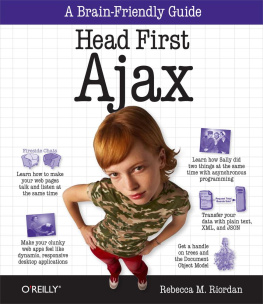




![Dino Esposito [Dino Esposito] - Microsoft® ASP.NET and AJAX: Architecting Web Applications](/uploads/posts/book/120575/thumbs/dino-esposito-dino-esposito-microsoft-asp-net.jpg)
